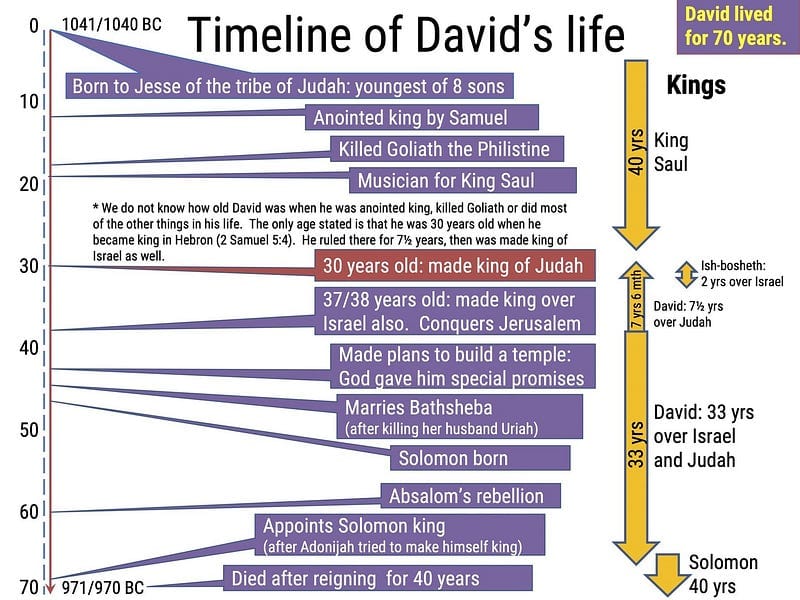Time to Make a Timeline of Your Life
How to see the ups and downs by dividing your own life into decades

Timelines are lines of time. By dividing your own life into decades, you can see patterns of ups and downs — where you are now, what you have been or done in the past, and what the future may be if you continue on that path.
Make a timeline of your own life
An easy way to do this is to take a blank sheet of paper and turn it horizontally (landscape instead of portrait mode) and draw a line across the middle. Then mark it off into decades, 1–10, 11–20, 21–30, 31–40, etc. You will see the past, present, and plan for the future. Put a few “high lights” of that decade above the line, and a few “low lights” below the line. (Write vertically if you need to fit it into that area.)
What this exercise does for you is this: You may identify patterns, see opportunities, God’s eternal plan, and make course corrections. You are leaving a lasting legacy whether you choose to or not. Your life is on display for others. This is a way to see what they see — a way for you to reflect in a mirror.
Examine the details of the life of David
Although the exact dates are not listed in the Bible, there are specific coordinates with passages and archeology that suggest that David was born in Bethlehem around ~40 years before 1000 BC during the reign of the first king of Israel (Saul), and he died ~around 40 years after 1000 BC after installing his son Solomon as the next king. Here is a detailed chronology of David’s life from Totally History.
1043 BC
Samuel the prophet anoints Saul as the first king of Israel. — 1 Samuel 10:1
1035 BC
Believed to be the approximate period that David is born in the town of Bethlehem.
1025 BC
Samuel goes to the town of Bethlehem and anoints the shepherd David as the future king of Israel. He is between the age of 10–12 years old. — 1 Samuel 16:13
1023 BC
David serves as a minstrel in Saul’s court after he is learned to be a talented musician. — 1 Samuel 16:21–22
Israel, led by King Saul, is at war with the Philistines.
1020 BC
The Philistines send their champion warrior Goliath against the shepherd boy David. David kills Goliath with a single shot from his sling. — 1 Samuel 17
1010 BC
King Saul fires David from his court but makes him a commander in his army. — 1 Samuel 18:13
David is successful as a warrior in Saul’s army that the king offers his daughter in marriage to David. — 1 Samuel 18:21
Jonathan, a son of King Saul, and David become the best friends and make an oath to one another regarding future generations. — 1 Samuel 20
1008 BC
David is threatened with bodily harm by Saul because of jealousy. He goes to Nob and receives the sword of Goliath from Ahimelech, a priest. — 1 Samuel 21. He then hides in the city of Gath, hometown of Goliath and pretends to be a crazy man. — 1 Samuel 21:10
1005 BC
With a chance to kill Saul, David spares the life of the man who had been trying to hunt him down in order to kill him. — 1 Samuel 24
1000 BC
Samuel the prophet dies. David meets Abigail and her husband Nabal. Nabal refuses to help David and his men. Abigail intervenes as David intends to do harm to Nabal. Nabal dies of natural causes, David marries Abigail. — 1 Samuel 25
After the death of Samuel, Saul consults a witch to call Samuel from the dead. Instead, Samuel predicts Saul’s death the following day. Saul, along with three of his sons die in a battle with the Philistines. — 1 Samuel 28:3–7
The Amalekites are destroyed by David and his men. — 1 Samuel 30
993 BC
David is anointed king of Judah with the help of his allies and he makes Hebron as the capital of his new “administration.” — 2 Samuel 2:7
A nation still divided between Israel and Judah, a civil war rages on between the kingdoms. The northern kingdom, Israel is led by Ishbosheth, one of the surviving sons of Saul. He is helped by Abner, a general loyal to Saul. — 2 Samuel 2:9–12
David and his kingdom is strengthened by expansion and alliances. Joab, one of Davids generals, kills Abner. — 2 Samuel 3
David finally reigns over all Israel and Judah. — 2 Samuel 5, 1 Chronicles 11
992 BC
David plans to build a temple for God. — 2 Samuel 7
982 BC
The Philistines, Moab, and Syrians are defeated by David and his army. — 2 Samuel 8
While taking a break from fighting Israel’s enemies, David sees the wife of Uriah, one of his soldiers, bathing out in the open from the rooftop of his palace. The woman was beautiful, her name was Bathsheba. — 2 Samuel 11
980 BC
David desired to have Bathsheba for himself and has an adulterous relationship with her. He eventually had Uriah killed. He is confronted by Nathan, a prophet of God, for his actions. — 2 Samuel 12
The wife of Uriah gives birth to a son by David, his name is Solomon. — 2 Samuel 12:24
978 BC
Amnon, one of David’s sons lust for his half-sister Tamar. Amnon forces himself on her, and is eventually killed by Absalom, Tamar’s brother. — 2 Samuel 13
David orders one his generals, Joab, to take a census to count the people of Israel . He later learns that he had ordered was not according to what God wanted and had consequences. — 1 Chronicles 21
A son of David, Absalom, conspires against his father by trying to draw the loyalties of the people from David. — 2 Samuel 14 & 15
976 BC
David leaves Jerusalem when he learns of his son Absalom’s intent to overthrow him. — 2 Samuel 15:13
974 BC
During a battle against David’s men, Absalom get himself caught on tree, he is then killed by Joab. — 2 Samuel 18
972 BC
David comes back to Jerusalem after his mourning of Absalom’s death. — 2 Samuel 19:14
The Philistines once again engage in battle against David and the Israelites. David is nearly killed by a giant, however, four giants were killed in the battle. The four were believed to have been brothers of Goliath. — 2 Samuel 21:15–22
963 BC
David gives Solomon and his other sons the responsibility of building God’s temple as he had originally hoped he would. — 1 Chronicles 22:6–19
Adonijah, David’s fourth son attempts to take over the kingdom of Israel when he learns that the health of David was failing. — 1 Kings 1:5
Nathan has Bathsheba ask David to name Solomon king after they learn of Adonijah’s plan. — 1 Kings 1:11
David gives the orders to Zadok the priest, Nathan the prophet, and Benaiah, one of his faithful and trusted men to crown Solomon as king over Israel. — 1 Kings 1:32–35
961 BC
David calls the people of Israel and Judah and formally hands over the plans for the temple to be built along with final instructions regarding his enemies. — 1 Chronicles 29:1–25, 1 Kings 2:1–9
David dies. Solomon becomes king of Israel. — 1 Kings 2:10–12
Learning from divine mentors
Each of the real people in the Bible are divine mentors. Through their lives recorded in history, you can see the timeline of their existence on earth. From their mistakes, you virtually learn what to do and not to do. In other words, you do not have to experience the pain of their problems.
You can learn from their mistakes. Their examples can keep you on the path of your new creation — or leave you stuck in the ruts of your own choices to stray and deviate from God’s plan for your life.


